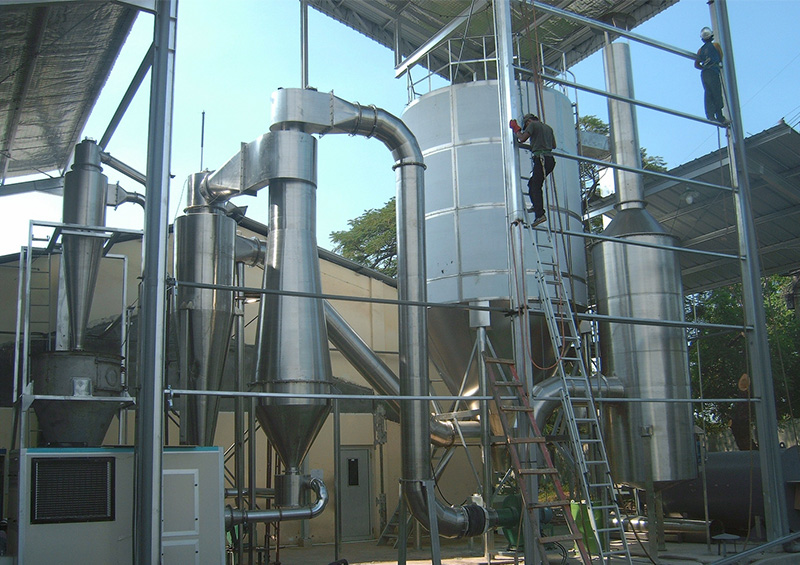What equipment is used in spray drying?
 Aug 02, 2024|
Aug 02, 2024| View:289
View:289Key Components of Spray Drying Equipment
Feed Preparation System: Before entering the dryer, the feedstock must be prepared. This may involve mixing, pre-heating, and homogenization to ensure a consistent and stable liquid feed.
Atomizer: The heart of the spray dryer is the atomizer, which disperses the liquid feed into fine droplets. There are several types of atomizers, including:
Pressure Nozzle Atomizers: Use high pressure to create a fine spray.
Two-Fluid Nozzle Atomizers: Combine the liquid feed with a pressurized gas (usually air or steam) to atomize the feed.
Rotary Atomizers: Utilize a spinning wheel or disc to throw out a thin film of liquid, which is then dried.
Drying Chamber: The drying chamber is where the actual drying process takes place. It can be designed in various shapes, such as cylindrical, conical, or rectangular, depending on the specific application and production requirements.
Hot Air Generator: The hot air needed for drying is typically generated by a combustion chamber, an electric heater, or a heat exchanger. The temperature and velocity of the air are critical parameters that affect the drying process.
Air Distribution System: Proper distribution of hot air is essential for uniform drying. This system ensures that the hot air is evenly spread across the drying chamber to maximize heat transfer efficiency.
Cyclone Separator: After the drying process, the dried powder and the exhaust air are separated using a cyclone separator. This device uses centrifugal force to separate the powder from the air stream.
Filter System: In some applications, a filter system may be used in conjunction with or instead of a cyclone separator to capture fine particles and ensure clean exhaust air.
Powder Collection System: The dried powder is collected at the bottom of the drying chamber or by a downstream collection system, which may include conveyors, vacuum systems, or pneumatic conveying.
Control System: Modern spray dryers are equipped with advanced control systems that monitor and control various parameters such as temperature, pressure, feed rate, and atomization. This ensures consistent product quality and process efficiency.
Additional Equipment and Considerations
Cooling System: In some cases, a cooling system may be necessary to reduce the temperature of the dried product before collection, especially for heat-sensitive materials.
Agglomeration System: For certain applications, it may be desirable to promote particle agglomeration to improve the flow properties of the powder. This can be achieved through the use of specialized equipment such as fluid bed agglomerators.
In-Line Blending: To ensure uniform distribution of ingredients, in-line blending systems may be used to mix the feedstock before it enters the spray dryer.
Cleaning-in-Place (CIP) Systems: For hygienic applications, such as in the food and pharmaceutical industries, CIP systems are used to clean the equipment without disassembly, reducing the risk of contamination.
Scale-Up Equipment: When scaling up from laboratory to industrial production, additional equipment such as larger atomizers, drying chambers, and more robust control systems may be required.

Applications of Spray Drying Equipment
Food Industry: Production of milk powder, coffee creamer, instant soups, and other food products.
Pharmaceutical Industry: Drying of drug substances, production of granules for tableting, and encapsulation of active ingredients.
Chemical Industry: Production of detergent powders, pigments, and other chemical products.
Materials Science: Fabrication of nanoparticles, ceramics, and other advanced materials.









